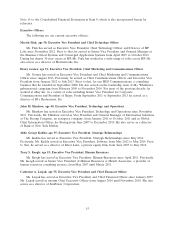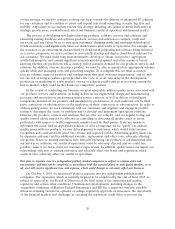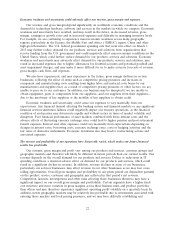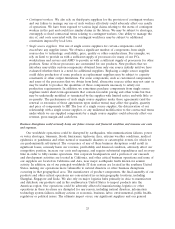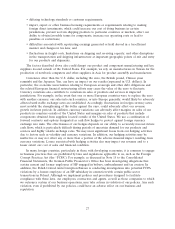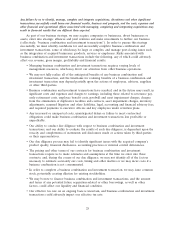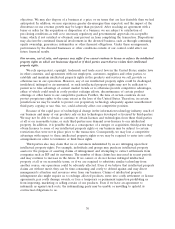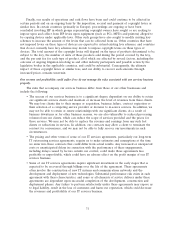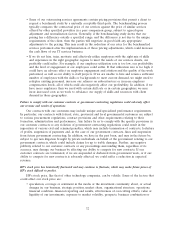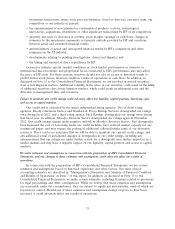HP 2014 Annual Report Download - page 31
Download and view the complete annual report
Please find page 31 of the 2014 HP annual report below. You can navigate through the pages in the report by either clicking on the pages listed below, or by using the keyword search tool below to find specific information within the annual report.maintaining the operating infrastructure necessary to support the high growth rate associated with some
of those markets. Market trends, industry shifts, competitive pressures, commoditization of products,
seasonal rebates, increased component or shipping costs, regulatory impacts and other factors may
result in reductions in revenue or pressure on gross margins of certain segments in a given period,
which may lead to adjustments to our operations. Moreover, our efforts to address the challenges
facing our business could increase the level of variability in our financial results because the rate at
which we are able to realize the benefits from those efforts may vary from period to period.
If we fail to manage the distribution of our products and services properly, our revenue, gross margins and
profitability could suffer.
We use a variety of distribution methods to sell our products and services, including third-party
resellers and distributors and both direct and indirect sales to enterprise accounts and consumers.
Successfully managing the interaction of our direct and indirect channel efforts to reach various
potential customer segments for our products and services is a complex process. Moreover, since each
distribution method has distinct risks and gross margins, our failure to implement the most
advantageous balance in the delivery model for our products and services could adversely affect our
revenue and gross margins and therefore our profitability. Other distribution risks are described below.
• Our financial results could be materially adversely affected due to channel conflicts or if the
financial conditions of our channel partners were to weaken.
Our results of operations may be adversely affected by any conflicts that might arise between
our various sales channels, the loss or deterioration of any alliance or distribution arrangement
or the loss of retail shelf space. Moreover, some of our wholesale and retail distributors may
have insufficient financial resources and may not be able to withstand changes in business
conditions, including economic weakness and industry consolidation. Many of our significant
distributors operate on narrow product margins and have been negatively affected by business
pressures. Considerable trade receivables that are not covered by collateral or credit insurance
are outstanding with our distribution and retail channel partners. Revenue from indirect sales
could suffer, and we could experience disruptions in distribution, if our distributors’ financial
conditions, abilities to borrow funds in the credit markets or operations weaken.
• Our inventory management is complex as we continue to sell a significant mix of products
through distributors.
We must manage inventory effectively, particularly with respect to sales to distributors, which
involves forecasting demand and pricing issues. Distributors may increase orders during periods
of product shortages, cancel orders if their inventory is too high or delay orders in anticipation
of new products. Distributors also may adjust their orders in response to the supply of our
products and the products of our competitors and seasonal fluctuations in end-user demand. Our
reliance upon indirect distribution methods may reduce visibility to demand and pricing issues,
and therefore make forecasting more difficult. If we have excess or obsolete inventory, we may
have to reduce our prices and write down inventory. Moreover, our use of indirect distribution
channels may limit our willingness or ability to adjust prices quickly and otherwise to respond to
pricing changes by competitors. We also may have limited ability to estimate future product
rebate redemptions in order to price our products effectively.
We depend on third-party suppliers, and our financial results could suffer if we fail to manage suppliers
properly.
Our operations depend on our ability to anticipate our needs for components, products and
services, as well as our suppliers’ ability to deliver sufficient quantities of quality components, products
and services at reasonable prices and in time for us to meet critical schedules. Given the wide variety
23




